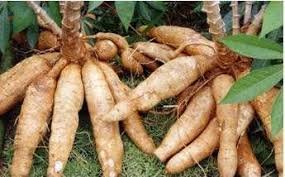
Cassava or also called cassava is a crop of tubers that are often found in community owned land and a variety of utilization. Umbinya can be processed into a wide range of foods, ranging from processed directly like boiled cassava, fried cassava, and chips until processed into semi-finished materials such as tapioca and become processed foods derived from the semi-finished material. The leaves can also be used as vegetables and animal feed ingredients.
The trunk is useful for planting material at the next planting. From all parts of the plant body, cassava tuber is the most processed and utilized as the main source of carbohydrate besides rice and corn. In addition to carbohydrates as the main composition of cassava tubers, nutrients and proteins are also contained in bulbs, The main nutrient contained is beta carotene that serves as provitamin A. Bulbs that contain beta carotene yellowish to yellow, while white does not contain beta carotene. The content of beta carotene in tubers reaches 8 micrograms and 11 micrograms per gram of fresh bulbs. When compared to the daily intake of vitamin A recommended by the European Food Safety Authority and the US Food and Nutrition Board, consuming 100 grams of yellow cassava can meet 27% of the minimum requirement of beta carotene per day. Gluten content found in wheat flour is not found on cassava flour, so that cassava flour can be consumed by people with celiac disease.
Other chemical compounds that need attention are cyanide (HCN) in the tubers that cause bitter taste and toxic. Cyanide content is only found in cassava which is generally not consumed, as in cassava rubber. However, in the eastern part of Indonesia, as in Southeast Maluku, local people continue to consume cassava with high cyanide content. The local people are able to eliminate cyanide in the tubers in the process of processing and processed into a healthy diet.
Judging from the variation of carbohydrate content, nutrients and other chemical compounds, can be known cassava not only consists of one type, but consists of various types.
the type of cassava that is collected is a type of cassava that has been known in farmers, namely Adira 1, Adira 4, Butter 2, Iding, and Roti. Based on the overall plant character, cassava collection has variations in the color and shape of leaves, stems and tubers. One example of variation among the types of cassava collection is the color of the leaves and the color of the petiole. In addition, cassava collection has been molecularly characterized (comparison of DNA band variation) and biochemical starch content, beta carotene and cyanide on tubers. Molecular characterization aims to identify the type of cassava, since differences in appearance do not necessarily lead to a different kind of cassava. Differences in external sightings are also influenced by the environmental conditions of cassava origin
which is different from other locations, thus affecting the color or shape of the plant.
Biochemical characterization and yield efficacy in cassava collection have been conducted and some cassava, such as Adira 1 type, have high yield yield and starch. Based on tuber flavor, cassava collection of Biotechnology Research Center can be categorized into two, namely cassava (cassava that can be consumed directly) and cassava containing bitter cyanide. The bitter cassava contains cyanide and is collected from Southeast Maluku, while cassava contains very little cyanide and is collected from other regions, such as Java, Sumatra and Nusa Tenggara.
Based on the color of bulbs, cassava collection can be grouped into cassava and sweet potato
yellow wood. Local yellow wood yams contain beta carotene consisting of several types, namely Butter 1, Butter 2, Adira 1, Lombok, and Yellow Cassava.
Improved plant properties include yield power, nutritional content and resistance to environmental stress and disease. One example of the improvement of cassava from our research is the FEC25 cassava which is a somaclonal variant of Adira 4. Induction of somaclonal variation in Adira 4 produces a new type that has beta-carotene content in the tubers, resulting in improved nutritional content in cassava.
The diversity of cassava is essential as an ingredient for the improvement of local cassava through plant breeding or biotechnology, such as the above technology. The results of this study are beneficial for farmers and communities to increase the selling value of cassava and obtain nutritious food.
sweet potato chips